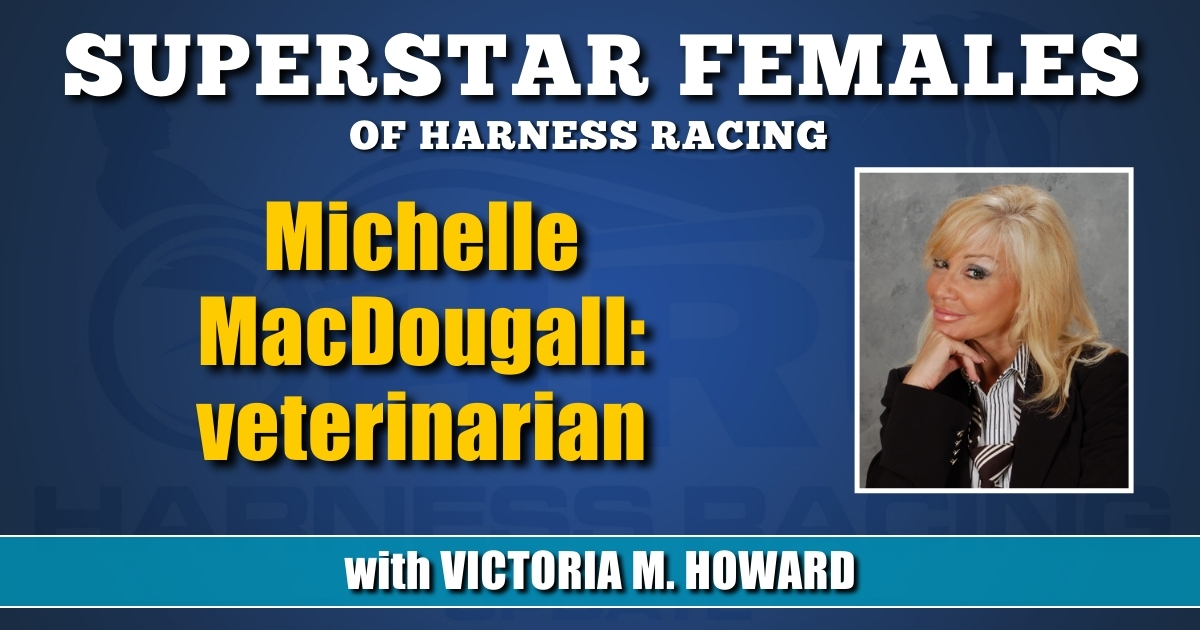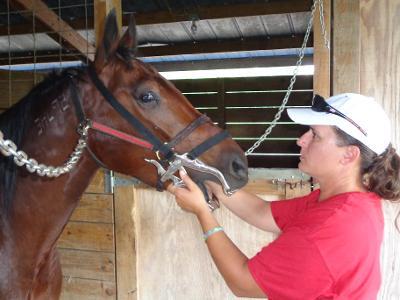

Michelle MacDougall — veterinarian
by Victoria Howard
When children are asked what they want to be when they grow up, many answer, “I want to be a veterinarian.” But it’s not easy to become a veterinarian for it takes 8-10 long years of studying. After completing an initial four-year bachelor’s degree program, it takes an additional four years of vet school.
And becoming a veterinarian doesn’t mean only working with cute, cuddly animals, for there are times when a vet may have to make a heartbreaking decision to put an animal out of his misery in the last moments of their life.
It takes a strong-willed person to be able to handle the emotional and physical stress that goes along with being a vet. So why do these people do it? They do it mainly to promote the health and welfare of the animals.
In 1960, 98 per cent of veterinarians were men, but today it’s about 50/50 and in the future the women will be dominating this field.
Michelle MacDougall was one of those little girls who decided early on that one day she would become a vet.
“I was about 10 or 11 when I decided to become a vet. My family didn’t have horses, but when I was 4 years old I attended a daycare held at a dairy farm and the neighbor was a horse trainer of retired standardbreds. That’s how I initially became involved with standardbreds,”MacDougall said. “In fact, that particular farm still works to continue to retrain and place retired standardbreds, and I assist at retraining and placement as often as possible.”
Born in Portland, ME, MacDougall started practicing equine medicine in 2009, juggling her time between making farm calls for pleasure and show horses around southern Maine, and attending racetracks based out of Scarborough Downs and neighboring training centers.
Today, MacDougall spends her summer working at Tioga Downs in New York and Pompano Park (Florida) in the winter.
Recently, she fulfilled her dream and purchased a farm that is located 10 miles from Tioga.
Presently, MacDougall owns some breeding stock, but is unable to own racehorses at the tracks where she practices.
What is the most rewarding thing about being a vet?
“When a stable makes me part of ‘the team,’ and when the trainer lets me in on the ‘nuts and bolts’ details of their operation. I can best identify possible areas for change and best help the horses, and when that happens and the horses start performing more and more consistently, I know I’ve been successful in helping them. Watching the horses that were previously struggling become more successful and then stand in the winner’s circle is proof that I am helping to make a difference.”
What is the most difficult thing?
“There’s not much easy about my job. I’d say the toughest thing is identifying areas of the horse that could use assistance and then follow through a plan that fits with the beliefs and values of each individual trainer and owner. There is no one way to run a stable and being able to adapt to the many different variations can be exhausting and frustrating.
“Every day I try to help educate on updated methods of nutrition, supplementation, and overall husbandry, while balancing the physical restraints — conformation, age, temperament, etc. — of the horses themselves, and the financial restraints of the connections with the newest treatments, diagnostics and therapies available.
“There is no one recipe for success, so sometimes it makes my job very difficult to find the right combinations for success for my clients. When I take time to understand what is going on, offer a treatment schedule or therapeutic plan and the horse does not respond as expected, clients will move on to another veterinarian. Losing clients that I work hard to help is probably the hardest part of the business.”
Do horses have feeling and emotions and do they understand humans?
“Absolutely! Just spend 10 minutes in the barn during feeding time and you will see a plethora of feelings and emotions. And, they definitely understand us. When an issue arises it is most often because people don’t understand them.
“People may not know this, but I watch every race live at both tracks I work at. There isn’t a race that goes to post that I’m not watching my client’s horses and continue gaining information to better help them.
“I also challenge myself each year to take a currently racing standardbred to the National Show held in New Jersey. I generally choose my un-ridden horse in May/June from my father’s string of racehorses. I break them to saddle myself and compete in August. I love showing how amazing the breed is by showcasing a newly saddle trained, currently racing horse in such a prestigious event as the National Standardbred Horse Sale.”
What is the future of harness racing?
“The future of harness racing is what we put into it. We need a constant influx of young people and newly interested people as drivers, trainers and owners.
“If we continue to put forward a good product and continue to work together as an industry, I think we can sustain a viable business, but we must remain united and rejuvenated.”
















